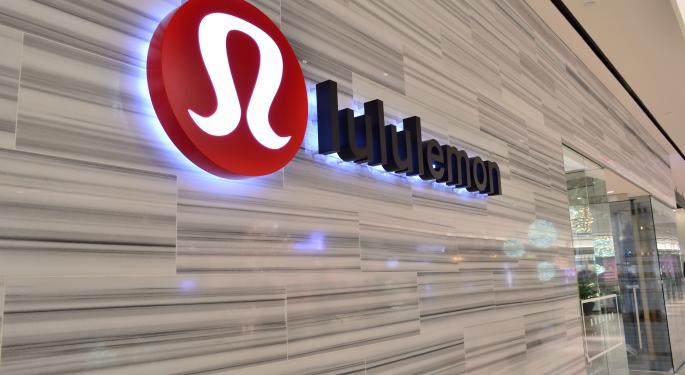6 Lululemon Analysts On Q1 Performance, Coronavirus Strategy

Public domain photo via Wikimedia.
Lululemon Athletica Inc LULU posted a 17% revenue decline in the first quarter Thursday despite 68% e-commerce growth.
Earnings of 22 cents per share missed the Street estimate by a penny, while gross margins beat the consensus by more than 100 basis points.
“We come away from the 1Q20 report positive, but still see valuation dislocation,” Morgan Stanley analyst Kimberly Greenberger said in a note. “Above-peer 1Q20 topline and gross margin results, preliminary 2Q20 guidance, and the China business trajectory highlight LULU’s resilience despite COVID19 headwinds.”
KeyBanc offered a more tepid response. “Results were OK, but even LULU is not immune to the current environment,” said analyst Edward Yruma.
- Lulu projected a third-quarter sales decline in the high single digits, with a return to sales growth in the fourth quarter. It similarly anticipates bottom-line declines in the second and third quarters followed by growth in the fourth.
Coronavirus Impact On Lululemon
Lulu’s inventory rose 41% throughout the quarter as management bucked industry trends and honored its vendor commitments.
The company also continued to pay rent to the landlords of shuttered shops and refused to furlough employees. As a result, it reported slight growth in SG&A costs while peer metrics declined.
“While LULU identified $130M in SG&A savings, we expect SG&A to deleverage for the year,” said KeyBanc's Yruma.
By UBS’ assessment, Lulu navigated the coronavirus better than most.
“First, LULU cited industry data showing the brand gained more athletic wear industry market share in Q1 than in any other quarter in recent years,” said UBS analyst Jay Sole.
“Second, LULU's merchandise margin increased 180 bps in an environment where almost every other Softlines company is experiencing many hundreds of basis points declines. Third, the company's eCommerce EBIT margin jumped 675 bps y/y to 44.6%, implying big potential structural margin improvement if LULU can lap large eCom gains in FY21 and stores return to normal productivity levels.”
In general, Lulu’s pandemic performance inspired analyst confidence.
“Comments that LULU saw its biggest market share gains in the athletic category in years (on product margins +180-bps!) affirm our view that structural tailwinds for LULU will be at the brand's back post-COVID-19, with additional tailwinds in a WFH [work from home] world as consumers emphasize comfort and wellness,” said RBC Capital Markets analyst Kate Fitzsimons.
Lululemon's Brick-And-Mortar Factor
According to KeyBanc, the results testify to the importance of Lulu’s store presence. The company is operating just 60% of its stores but expects to have nearly all reopened by the end of June. Those that are open boast 75% to 100% productivity.
Morgan Stanley suspects that, given the company’s recovery in China stores, non-U.S. stores could return to pre-coronavirus comps by August. This represents a much faster recovery than peers are expected to experience.
In the meantime, the company is expected to benefit from an environment encouraging online shopping.
“Ecomm order volumes are currently equivalent to holiday season levels,” said BofA Securities analyst Rafe Jadrosich. “The 2023 goal of quadrupling ecomm sales from 2018 remains intact and international also saw strong demand.”
The Big Picture For Lululemon
Needham stressed the importance of the historical context of Lulu’s earnings miss.
“LULU did not miss its sales or EPS guidance once between 2015-2019,” said analyst Rick Patel, noting that the company consistently beat guidance.
“If these trends hold in Q2, then theoretically Street numbers should go up, not down. Moreover, the market is focused on FY21 and there is little from LULU's 1Q20 report indicating FY21 won't be a strong bounce-back year.”
Patel said Lulu’s story remains largely intact.
“We saw underlying strength that we expect will be sustainable and beneficial to future quarters, notably in digital.”
The Lululemon Ratings
- BofA Securities maintained a Buy rating and $340 price target;
- KeyBanc Capital Markets maintained a Sector Weight rating;
- Morgan Stanley maintained an Equal-weight rating and $296 target;
- Needham maintained a Buy rating and raised its target from $225 to $345;
- RBC Capital Markets maintained a Buy rating and cut its target from $360 to $348; and
- UBS maintained a Neutral rating and $230 target.
© 2020 Benzinga.com. Benzinga does not provide investment advice. All rights reserved.



